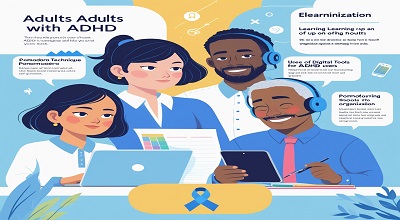Adult ADHD Learning Strategies
Adult ADHD Learning Strategies: Attention Deficit Hyperactivity Disorder (ADHD) is often associated with children, but many adults continue to experience its effects, particularly in learning and productivity. Adults with ADHD may struggle with focus, organization, time management, and retaining information. However, with the right strategies, they can enhance their learning abilities and achieve their goals effectively.
This comprehensive guide explores the latest ADHD learning strategies for adults, providing actionable examples to help improve focus, retention, and productivity.
Understanding ADHD in Adults
What is Adult ADHD?
ADHD is a neurodevelopmental disorder characterized by inattention, hyperactivity, and impulsivity. In adults, symptoms may manifest as:
- Difficulty concentrating on tasks
- Poor time management
- Forgetfulness
- Impulsive decision-making
- Struggles with organization
How ADHD Affects Learning
Adults with ADHD may find traditional learning methods challenging due to:
- Short attention spans – Difficulty staying engaged in long lectures or reading sessions.
- Working memory deficits – Trouble retaining and recalling information.
- Procrastination – Delaying tasks until the last minute.
- Disorganization – Struggling to keep track of assignments, deadlines, and materials.
Understanding these challenges is the first step in developing effective learning strategies.
Latest ADHD Learning Strategies for Adults (with Examples)
1. Structured Time Management Techniques
Strategy: The Pomodoro Technique
- How it works: Break work into 25-minute focused sessions (Pomodoros) followed by a 5-minute break. After four Pomodoros, take a longer break (15-30 minutes).
- Example: If studying for an exam, set a timer for 25 minutes, focus solely on reading, then take a short walk before resuming.
Strategy: Time Blocking
- How it works: Assign specific blocks of time for different tasks.
- Example:
- 9:00 AM – 10:00 AM: Read Chapter 1
- 10:00 AM – 10:15 AM: Break
- 10:15 AM – 11:15 AM: Practice problems
2. Active Learning Methods
Strategy: The Feynman Technique
- How it works: Simplify complex topics by teaching them in simple terms.
- Example: After learning a concept, explain it aloud as if teaching someone with no prior knowledge.
Strategy: Mind Mapping
- How it works: Visually organize information using diagrams.
- Example: When learning project management, create a mind map connecting key concepts like planning, execution, and monitoring.
3. Minimizing Distractions
Strategy: Digital Detox
- How it works: Turn off notifications and use apps like Forest or Focus@Will to stay on track.
- Example: Before studying, enable “Do Not Disturb” mode and close unnecessary browser tabs.
Strategy: Dedicated Workspace
- How it works: Create a clutter-free, distraction-free study area.
- Example: Use noise-canceling headphones and keep only essential materials on the desk.
4. Memory Enhancement Techniques
Strategy: Spaced Repetition
- How it works: Review material at increasing intervals to improve retention.
- Example: Use apps like Anki to schedule flashcard reviews.
Strategy: Mnemonics & Acronyms
- How it works: Use memory aids to recall information.
- Example: To remember the Great Lakes (Huron, Ontario, Michigan, Erie, Superior), use the acronym HOMES.
5. Leveraging Technology
Strategy: Speech-to-Text Tools
- How it works: Dictate notes instead of typing.
- Example: Use Otter.ai to transcribe lectures in real time.
Strategy: Task Management Apps
- How it works: Use apps like Trello or Todoist to organize tasks.
- Example: Create a board with columns for “To-Do,” “In Progress,” and “Completed.”
6. Physical & Mental Wellness Strategies
Strategy: Regular Exercise
- How it works: Physical activity boosts dopamine, improving focus.
- Example: Take a 10-minute walk before studying to enhance concentration.
Strategy: Mindfulness & Meditation
- How it works: Reduces impulsivity and improves attention span.
- Example: Practice 5-minute guided meditation before starting a task.
Case Studies: Real-Life Applications
1: University Student with ADHD
- Challenge: Difficulty focusing during lectures.
- Solution: Used live transcription apps and Pomodoro breaks.
- Outcome: Improved note-taking and exam performance.
2: Working Professional with ADHD
- Challenge: Missed deadlines due to poor time management.
- Solution: Implemented time blocking and Trello boards.
- Outcome: Increased productivity and reduced stress.
FAQs on Adult ADHD Learning Strategies
1. Can adults develop ADHD later in life?
No, ADHD is a neurodevelopmental disorder present from childhood, but symptoms may become more noticeable in adulthood due to increased responsibilities.
2. What are the best apps for ADHD time management?
Popular apps include:
- Todoist (task management)
- Forest (focus timer)
- Trello (project organization)
3. How can I improve my memory with ADHD?
Use spaced repetition, mnemonics, and visualization techniques to enhance recall.
4. Does diet affect ADHD symptoms?
Yes, a balanced diet with omega-3s, protein, and limited sugar can improve focus.
5. Are there ADHD-friendly learning environments?
Yes, quiet spaces with minimal distractions, good lighting, and ergonomic setups help.
Conclusion
Adults with ADHD can overcome learning challenges by implementing structured strategies like time management, active learning, memory techniques, and technology tools. By tailoring these methods to individual needs, they can enhance focus, retention, and productivity.
Free Link: Street Fighter Duel APK
